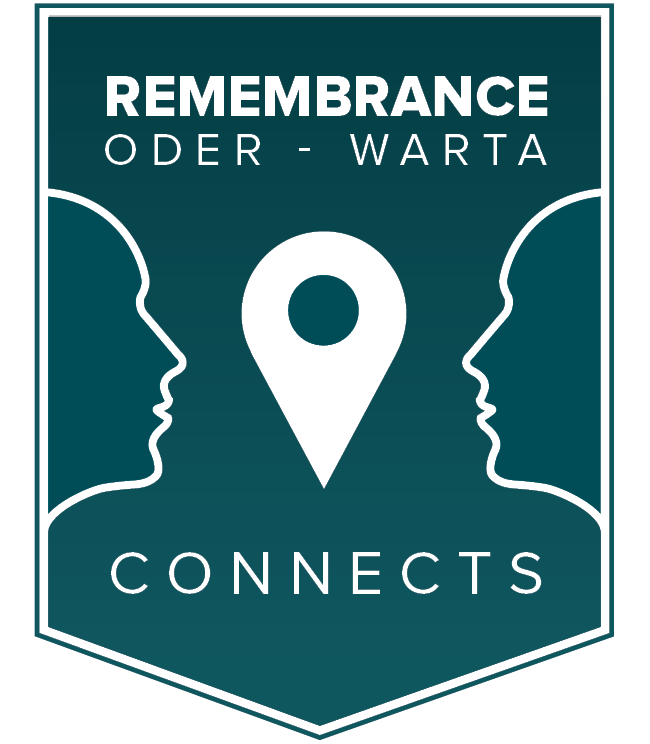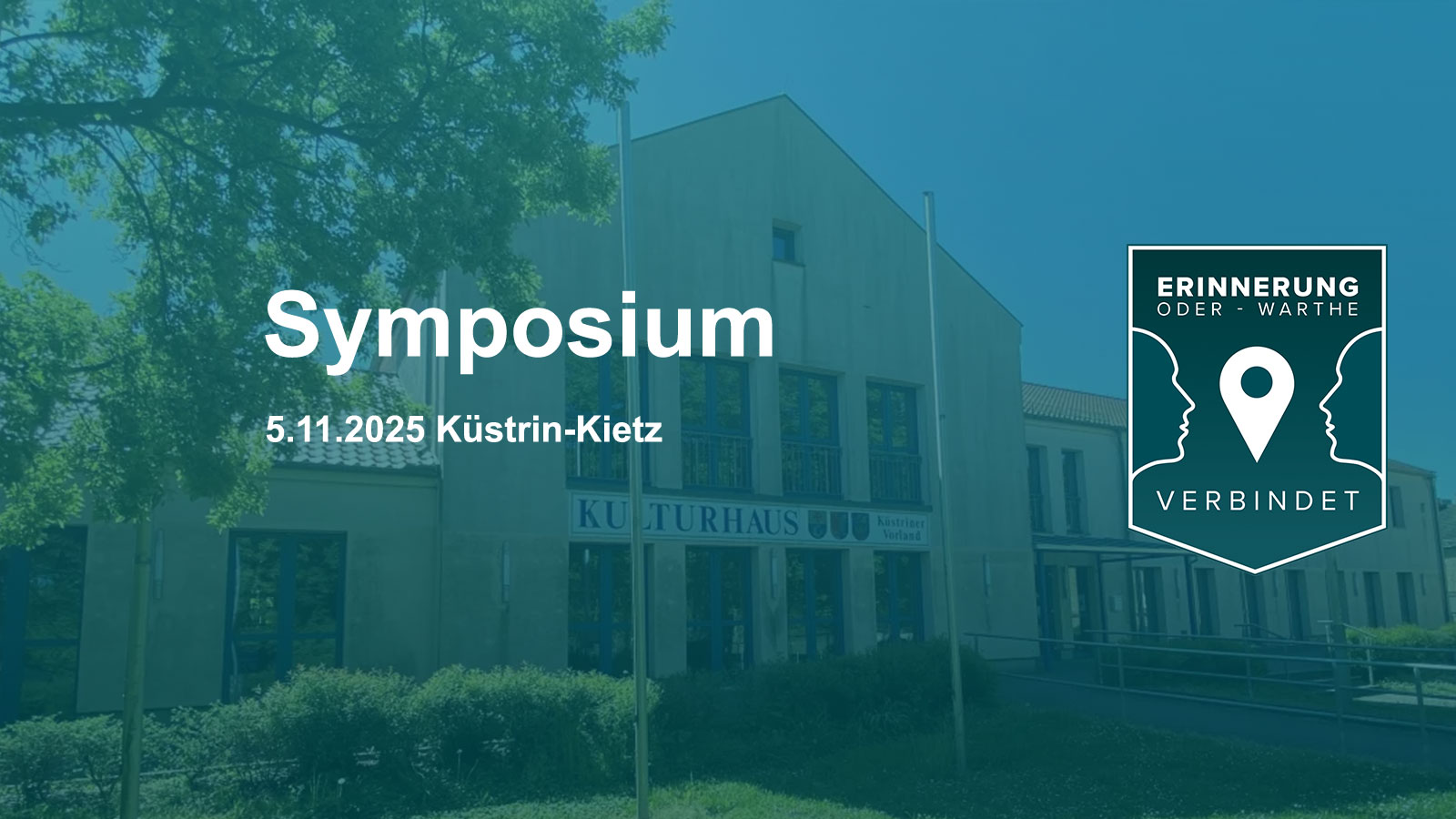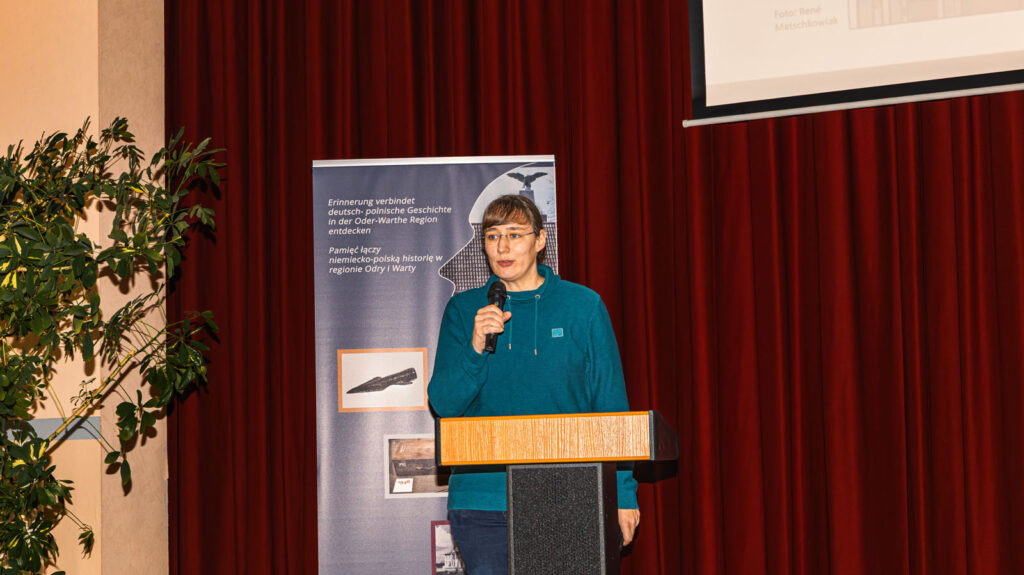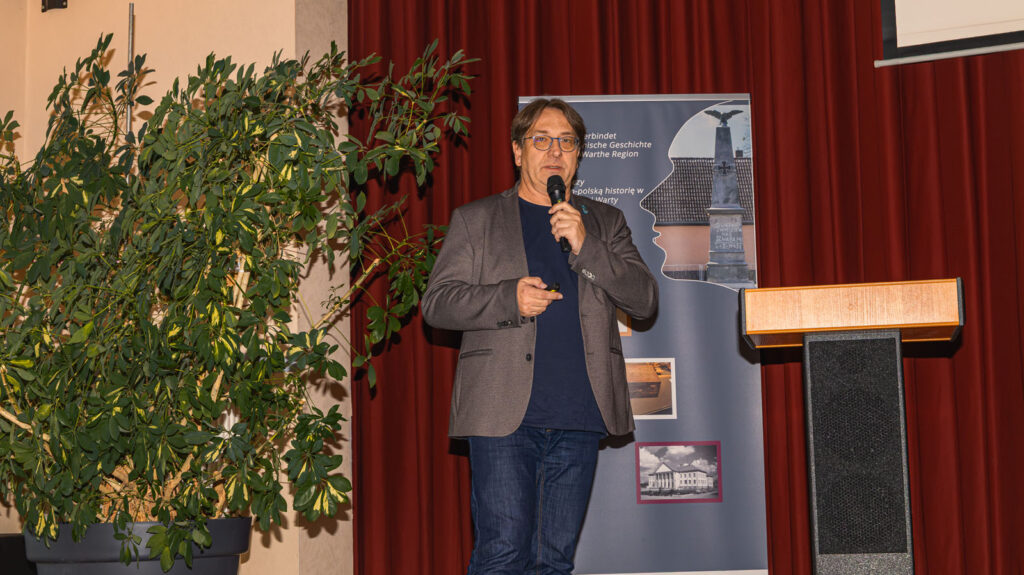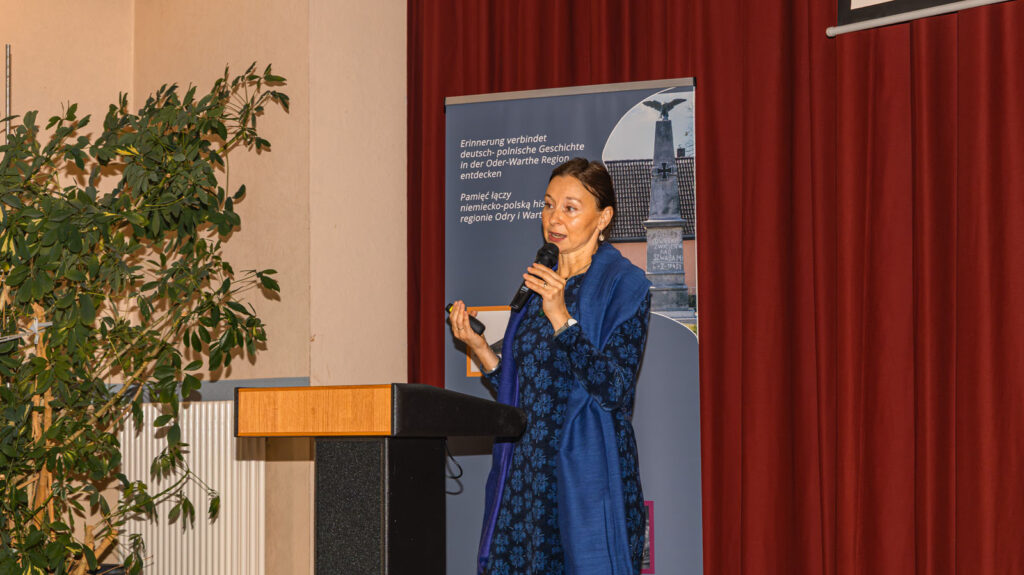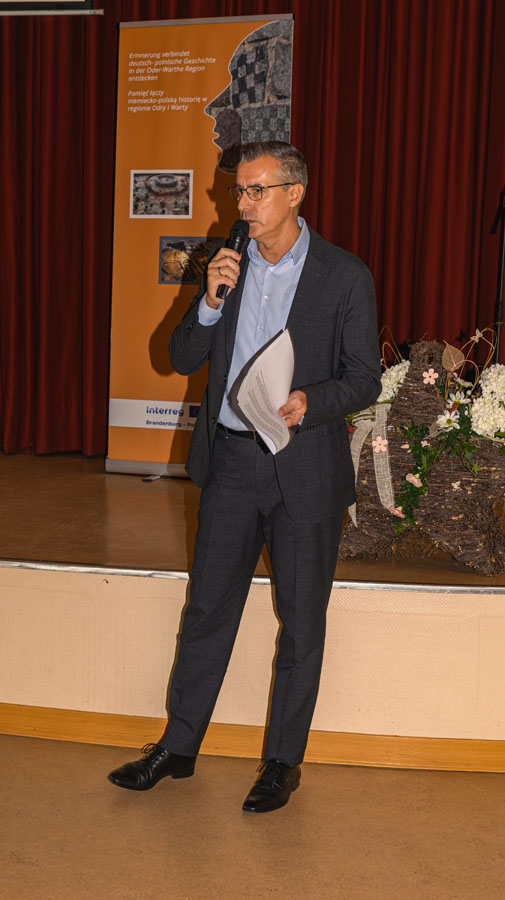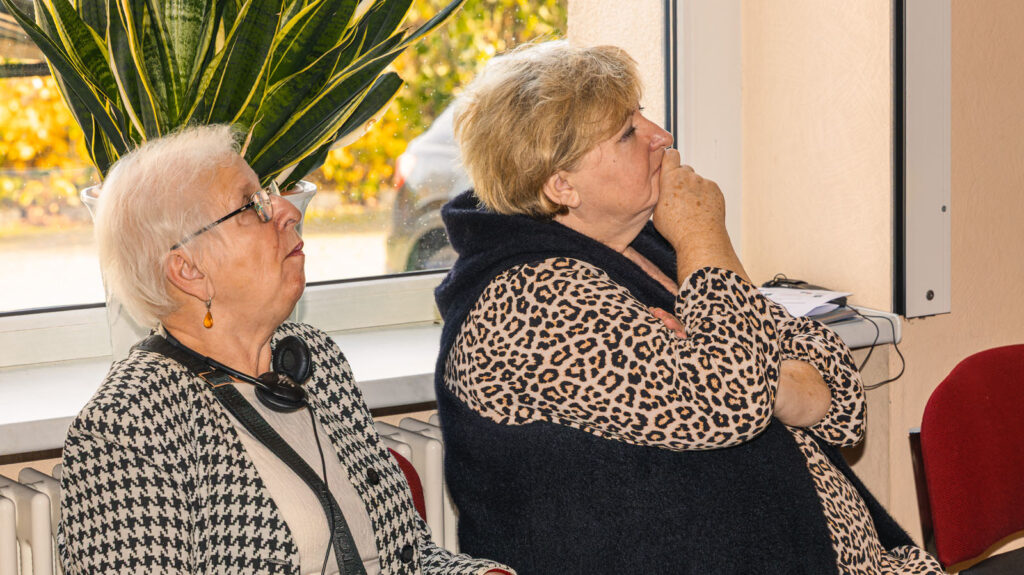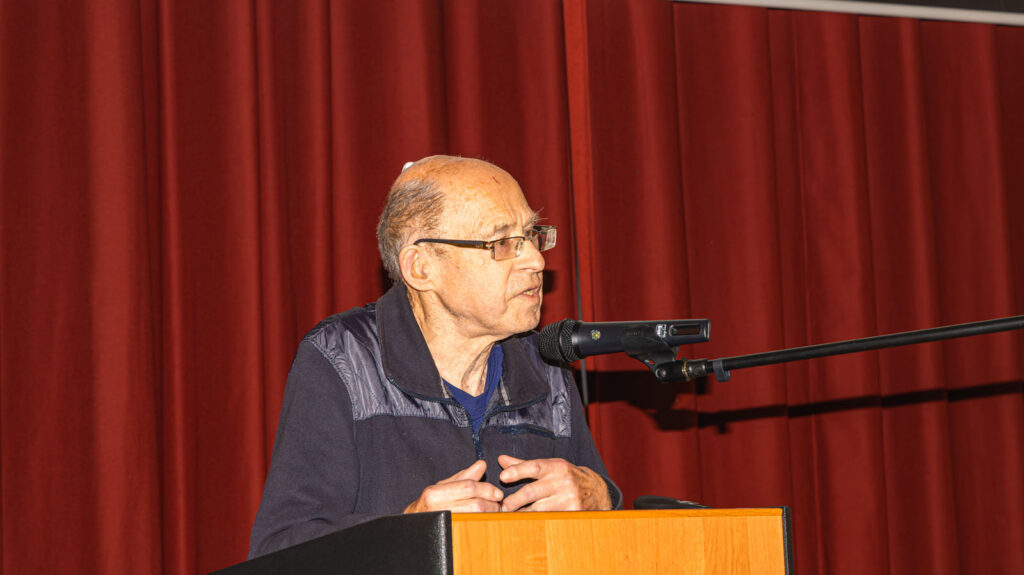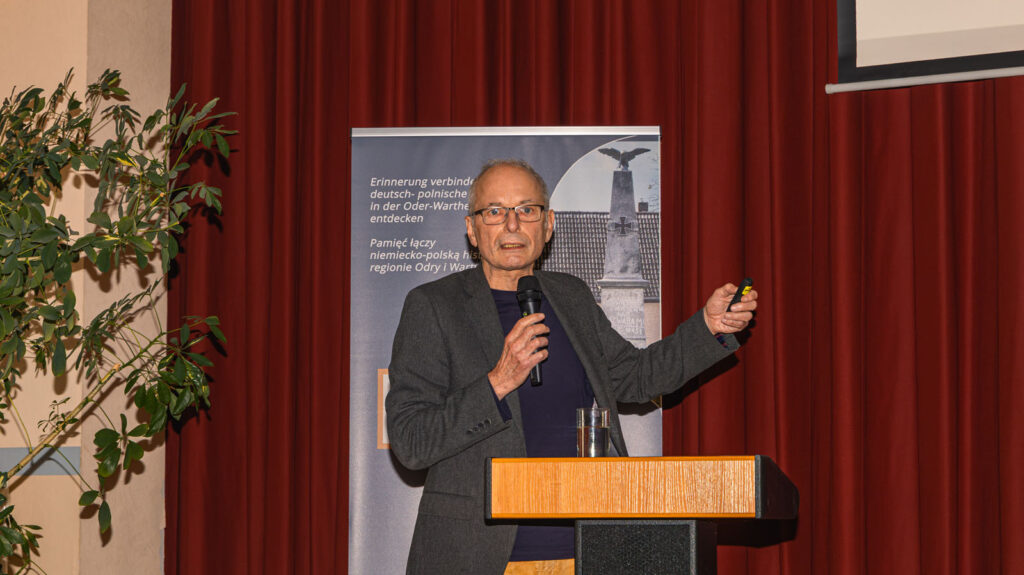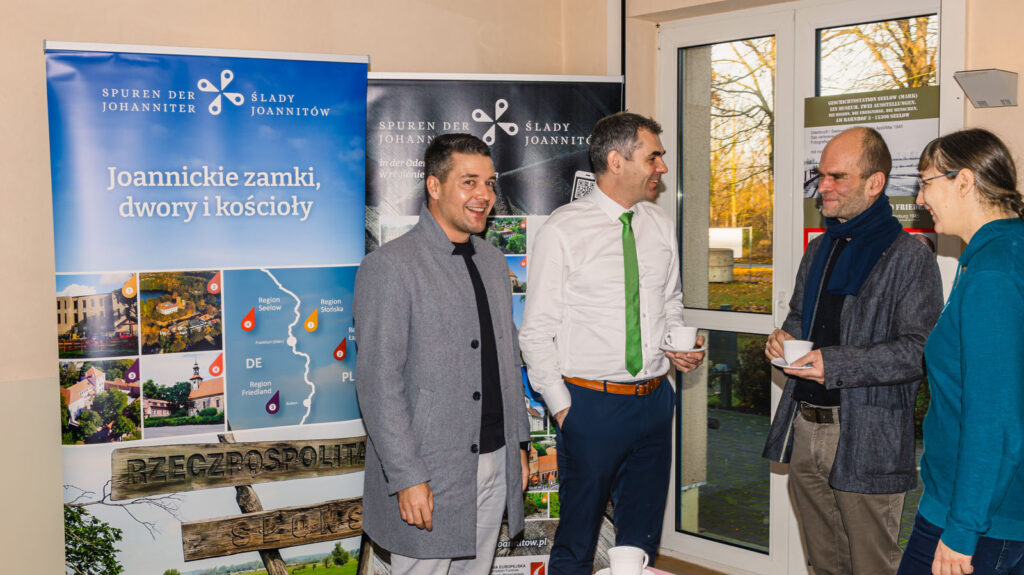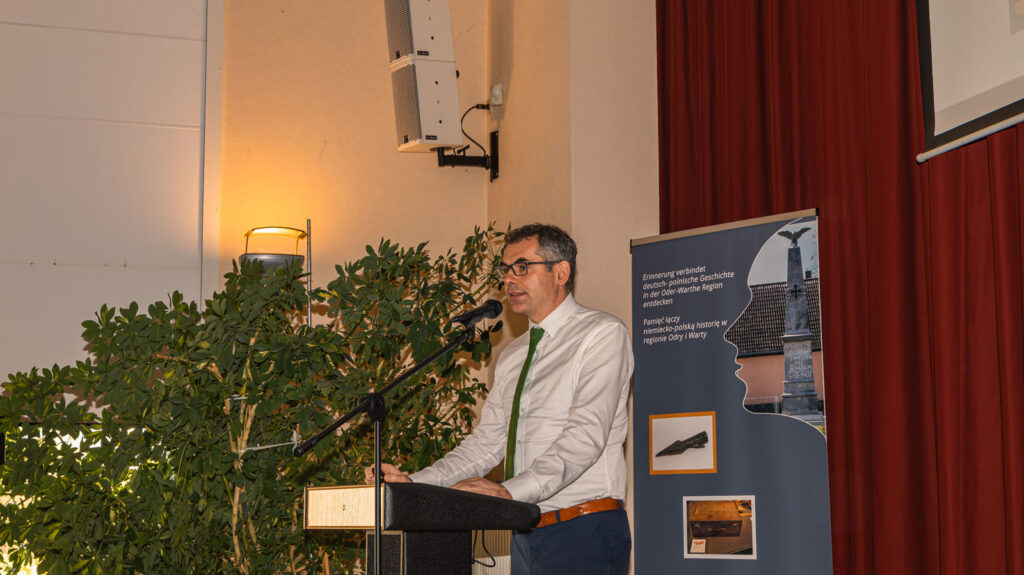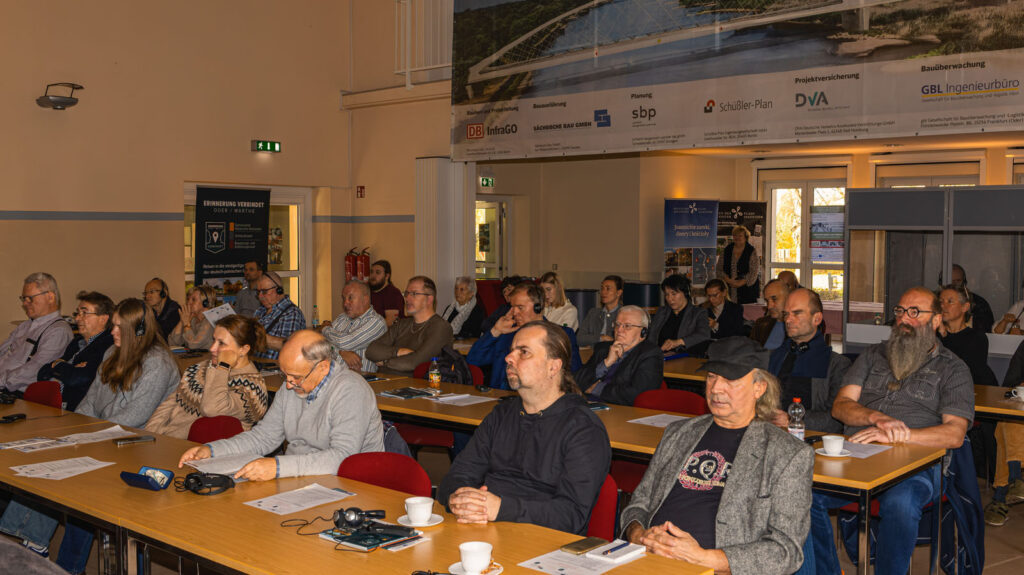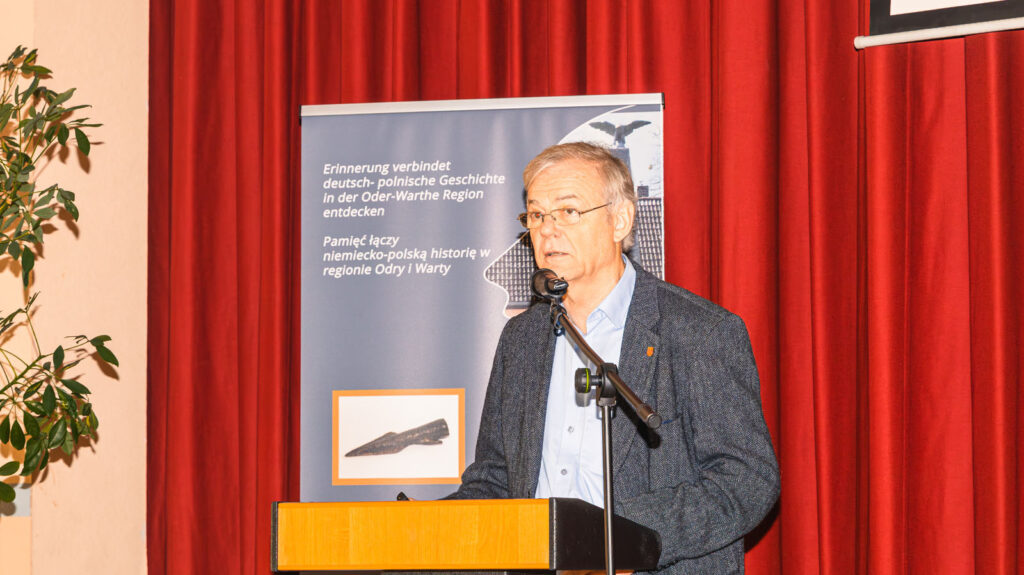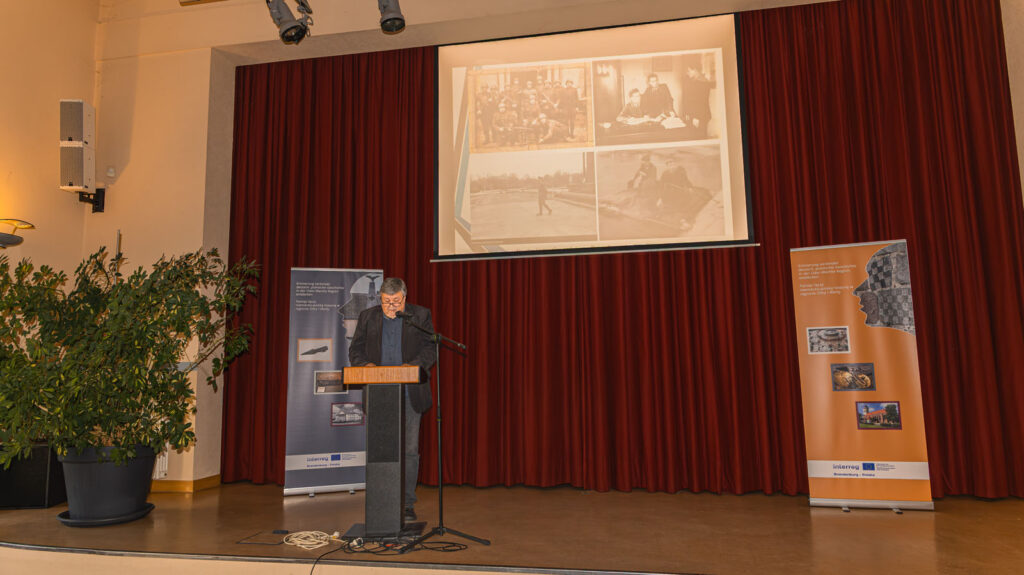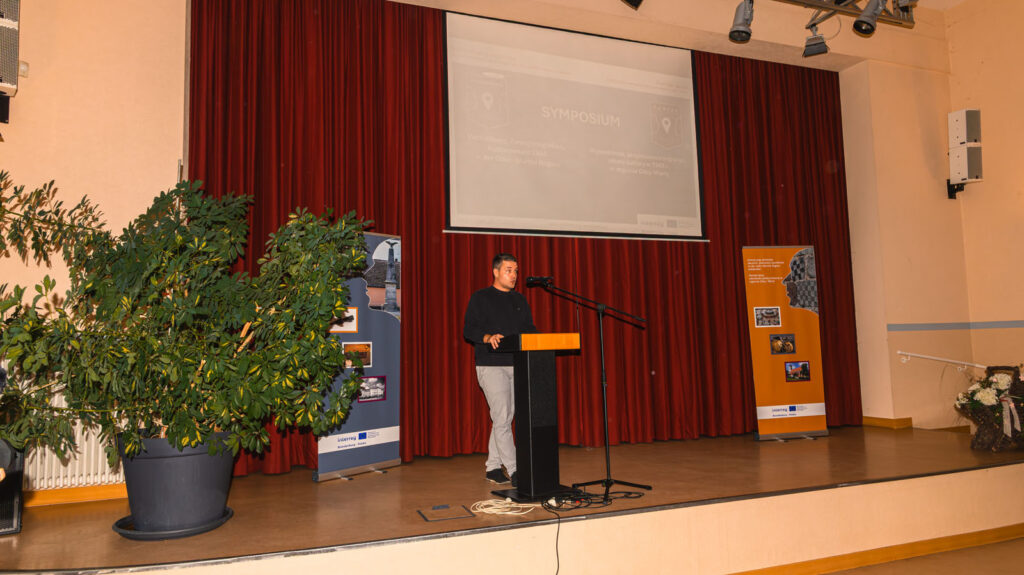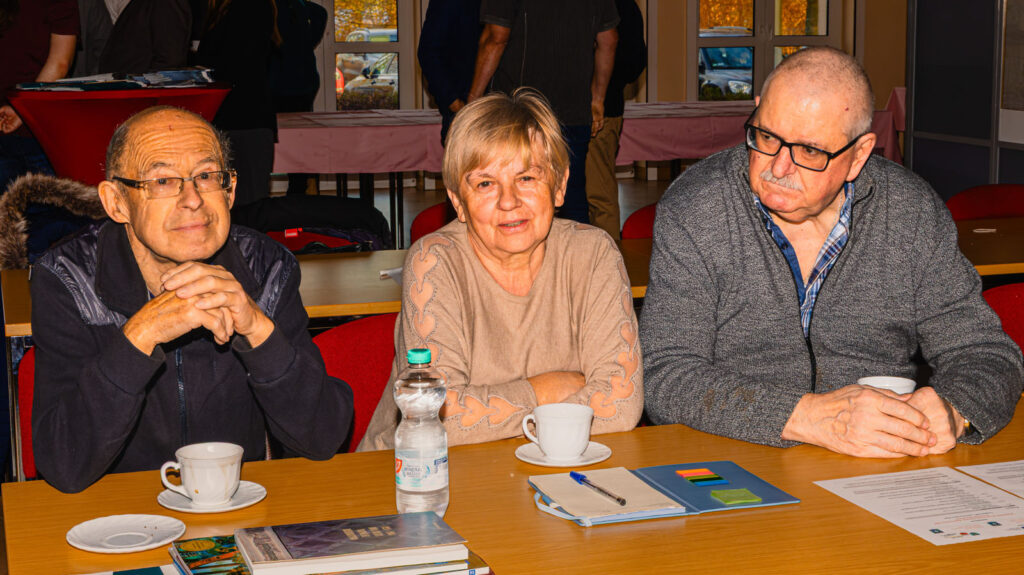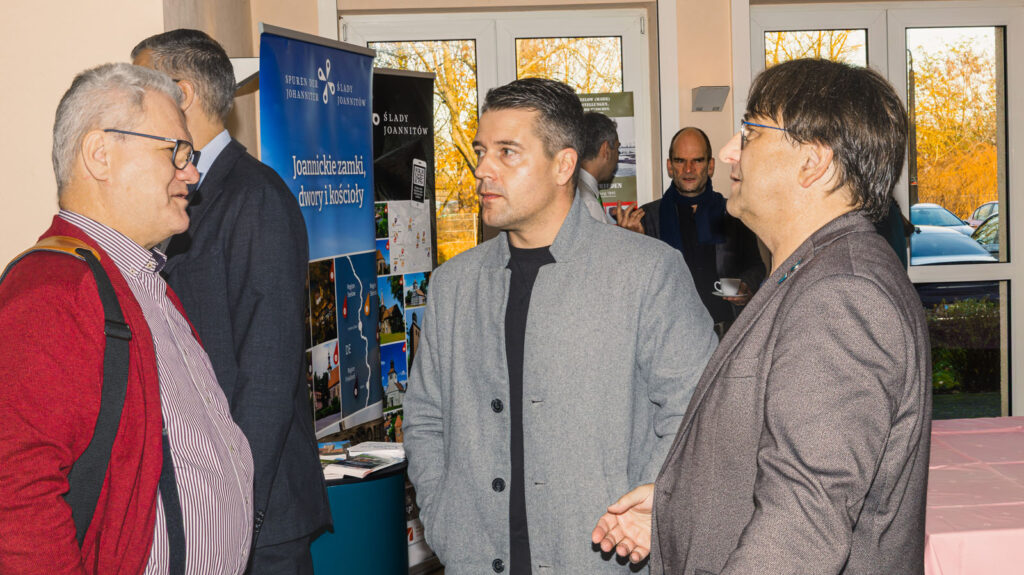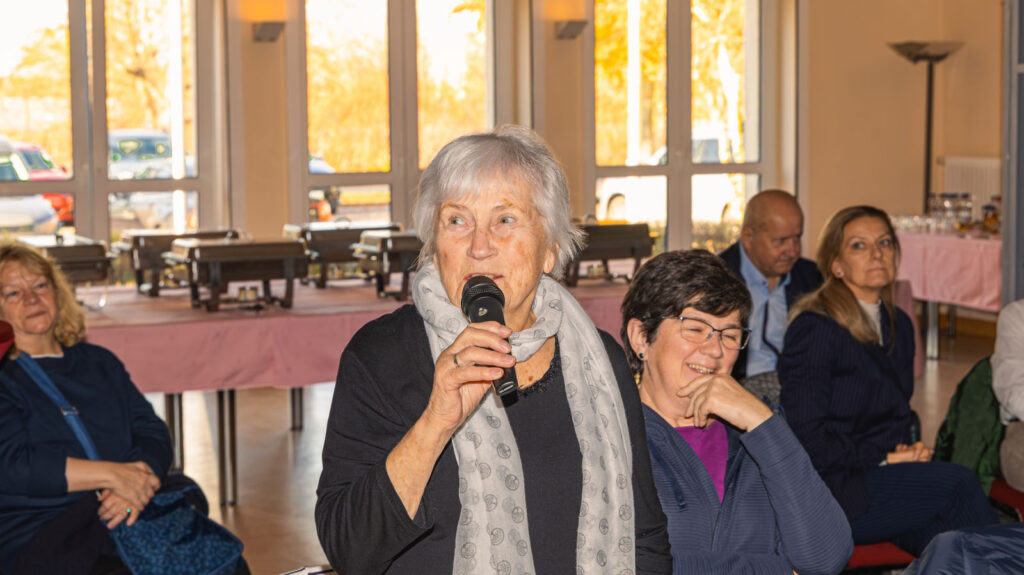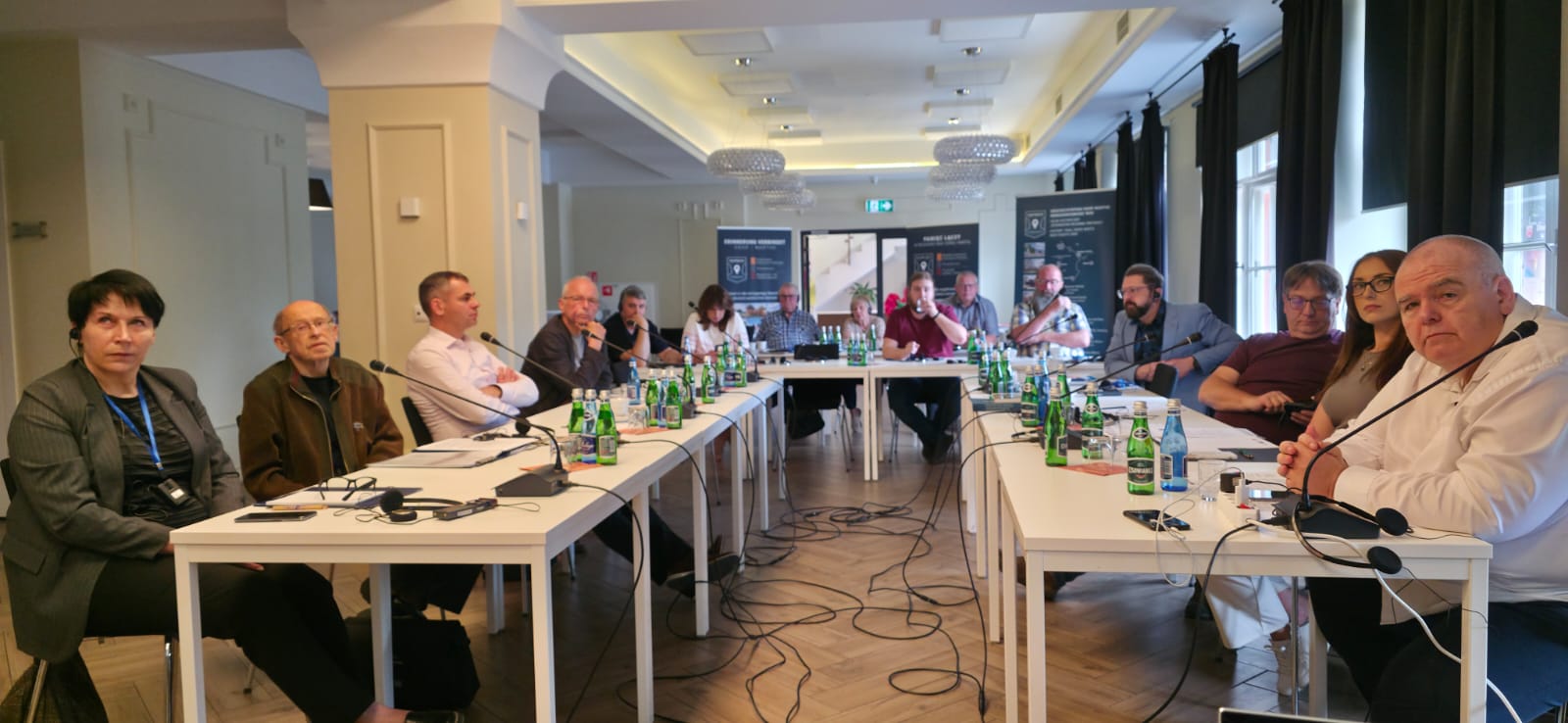5 November 2025, Kulturhaus Küstriner Vorland (DE)
The symposium „Expulsion, Forced Migration, Loss of Culture 1945 in the Oder-Warthe Region“ focussed on the complex German-Polish history in the border region, particularly after the Second World War. It opened up a space for German-Polish dialogue about the profound upheavals of 1945.
The region exemplifies forced migration, loss and new beginnings, the after-effects of which can still be felt today. Here, memory is understood as a relationship - open, multi-perspective and in dialogue. The aim is not a ready-made narrative, but a responsible narrative that combines science and personal experience, involves young people and builds bridges between research, education and the public.
The „Remembrance connects“ funding project creates a cross-border network that makes historical sites visible and preserves traces. In this way, remembrance becomes a process that opens up horizons, enables understanding and shapes the future.
Programme:
Eröffnung:
Robert Nitz
Bürgermeister Stadt Seelow (Mark)
„Geschichte bewahren – Zukunft gestalten: Begrüßung zum Symposium in der Oder-Warthe-Region“
Dirk Röder
City of Seelow (Mark)
Eröffnungsbeitrag Symposium „Vertreibung, Zwangsmigration, Kulturverlust 1945 in der Oder-Warthe-Region“
Panel I: Historical classification
Przemysław Słowiński
Population changes in the German-Polish border region after the Second World War. History. Politics. Semantics.
Reinhard Schmook
Oderland Museum Bad Freienwalde
Flight and expulsion in the Oder-Warthe region using the example of Königsberg/Nm. (Chojna)
The speech deals with the topic of flight and expulsion in the Oder-Warthe region using the example of the district town of Königsberg/Neumark. The rapid approach of the Red Army at the end of January/beginning of February 1945 led to chaotic conditions here, because the party authorities prevented an orderly evacuation of the town until the very end. What then happened in Königsberg from 4 April to 23 June 1945 is described by the local second pastor Fritz Bliedner. He was a member of the Confessing Church, an opposition movement of Protestant Christians against attempts to bring the doctrine and organisation of the German Protestant Church into line with National Socialism. The entries in his diary are both credible and illuminating, allowing us to form a picture of the terrible events between the invasion of the Red Army and the expulsion of the city's population. They reflect death and destruction, the suffering of the remaining inhabitants and, finally, the extensive destruction of the town with its medieval monuments.
Ryszard Skalba
Director of the Kostrzyn Fortress Museum
The pioneering years of Kostrzyn in Poland
In mid-1945, Küstrin's Old Town and New Town were among the most destroyed towns in the former German Reich. The expulsion of the German inhabitants paved the way for Polish settlers, and the town was given a new name - Kostrzyn. The first settlers were mainly railway workers and customs officials who were supposed to ensure the functioning of the basic transport and border structures. Over time, they were joined by labourers who worked on the reconstruction of the pulp and paper mill, which revived economic life.
Kostrzyn developed on the site of the former New Town, constructing new buildings and facilities from scratch. Offices, schools and workplaces were gradually established and the town increasingly gained its Polish character.
Tim Müller
Eigenbetrieb Kulturbetriebe Frankfurt (Oder) Viadrina Municipal Museum
The lost museum. The Frankfurt Oderland Museum in the former Lienauhaus
Agnieszka Lindenhayn-Fiedorowicz
Eigenbetrieb Kulturbetriebe Frankfurt (Oder) Viadrina Municipal Museum
A Cranach in the provinces - and his fate after 1945
The Neudamm Altarpiece from the workshop of Lucas Cranach the Younger was one of the most important Renaissance retables in the Oder region. Donated in 1562 by Duchess Katharina von Braunschweig-Wolfenbüttel for the town church in Neudamm (Dębno), it was transferred to the village church in Nabern (Oborzany) after the church was rebuilt in 1852. Its post-war fate is exemplary for the loss of movable cultural assets in the Oder-Warthe region. The destruction caused by the war, the passage of the Red Army and the subsequent population movements led to the destruction, looting or devaluation of numerous church furnishings. The population exchange was accompanied by a change of denomination: the newly settled Catholic Poles were often indifferent or hostile to Protestant art. As a result, the Neudammer Altar was dismantled in the 1950s and banished to the attic, where it suffered severe damage and fell into oblivion. It was not until 1998 that it was rediscovered by a regional historian, badly damaged and incomplete. In 2002, it was taken away for restoration - not to a specialised workshop, but to the private workshop of the diocesan conservator in Szczecin. As the altar was not entered in the list of monuments after 1945, it is still not subject to state protection. The lecture takes this work as a case study to visualise the complex post-war fates of works of art in the region: between war destruction, confessional alienation, neglect and uncertain preservation.
Henriette Brendler
Frankfurt (Oder)
Saved, lost, returned: the medieval choir windows of St Mary's in Frankfurt (Oder)
The three late Gothic choir windows of St Mary's Church in Frankfurt (Oder) are not called a glass treasure without good reason. Nowhere else in Brandenburg is there a comparable collection of medieval stained glass; the Antichrist window is even considered unique. The article focusses on the fate of the Frankfurt Picture Bible during the Second World War, the handling of this subject in the GDR and the long journey from rediscovery to repatriation and restoration.
Marek Karolczak
Myślibórz
Material losses of cultural heritage using the example of the municipality of Myślibórz (Soldin)
The lecture describes the situation in Soldin/Myślibórz in February 1945 after the invasion of the Soviet army and presents preserved documents from the collections of the Museum of the Myślibórz Lake District in Myślibórz. They show the fate of the exhibits that were in the collections of the Regional Museum - Museum of Local History of the Soldin District, which existed from 1928 to 1945.
Christian Hirte
Museum Lebuser Land Müncheberg
The loss of inventory in the Museum Lebuser Land Müncheberg 1945 ff.
Lunch break
and tour of the Museum in the Kulturhaus Küstrin-Kietz under the professional supervision of the Association for the History of Küstrin e.V.
Panel II: Local perspectives - cultural loss - cultural appropriation?
Kamila Pałubicka
Kulturerben e.V.
Artistic-creative history mediation using the example of the Martyrium Museum Słońsk (Sonnenburg)
The town of Słońsk (formerly Sonnenburg) is a prime example of the difficult legacy of National Socialism. One of the first concentration camps was located here, where numerous political prisoners from all over Europe were imprisoned. In the final phase of the Second World War, more than 800 prisoners fell victim to a planned massacre. Dealing with this historical legacy and remembering the victims remains a central social task.
The Kulturerben e.V. association has been working with German-Polish youth groups for over ten years on innovative artistic approaches to this difficult chapter of European history. In various projects, performative, media and participatory approaches have been trialled that enable young people to actively engage with the culture of remembrance and develop their own forms of expression.
As part of the current workshops, we combine historical knowledge transfer with artistic and creative methods. After a guided tour of the central places of remembrance in Słońsk and a visit to the museum memorial, the young people work independently in German-Polish teams to create lay films. This technique allows them to combine images, symbols and texts and condense their reflections on the history of Sonnenburg into short film sequences. The work is complemented by spoken word texts and audio recordings, which are incorporated into a joint performance for the memorial service.
The result is a multi-layered, transnational approach to the culture of remembrance that combines historical facts with creative self-activity and enables young people to experience themselves as active shapers of a living European culture of remembrance.
Thomas Drewing
History and local history association Gusow-Platkow e.V.
New museums - the approach of the next generation
A conference volume will be produced, which will contain additional specialist contributions:
Andrzej Kirmiel
Alf Kowalski Międzyrzecz Museum in Międzyrzecz
Międzyrzecz and the Międzyrzecz Land 1933-1947 in the face of great changes
The article presents the history of the inhabitants of Międzyrzecz and the Międzyrzecz region in the years 1933-1947 from the perspective of national changes. The author describes the process that led to the destruction of the multi-ethnic structure of the city that had developed over centuries. He reports on the history of the Jewish community of Międzyrzecz, which was the first to disappear from the ethnic landscape, and describes the further population shifts, this time after the end of the Second World War. At that time, the German inhabitants of the town and the neighbouring villages had to leave their homes. What remained were the locals, the Polish population, who spoke little or no Polish and with whom the new rulers did not really know what to do. In the end, they were treated like foreigners who expressed their desire to remain in Poland and were subjected to the same scrutiny. The final part of the national changes in the area between the Międzyrzecz and Wisła rivers was the influx of people from central and eastern Poland, as well as Ukrainians and Lemkos from south-east Poland, who had been expelled from their homeland as part of the „Wisła” campaign, which began in 1947.
Such mass resettlements lead to a situation in which ethnically foreign population groups arrive in areas where there are no longer any former inhabitants, but everything around them bears witness to their long-standing presence. The author describes what happened to the material culture of the communities that lived in Międzyrzecz and the neighbouring villages until 1945.
Andy Steinhauf
Association for the History of Küstrin e.V.
The Küstrin / Alt-Drewitz reception camp 1945
Der Artikel beleuchtet die Entstehung und kurze Existenz des Auffanglagers Küstrin/Alt-Drewitz im Herbst 1945. Nach dem Befehl der sowjetischen Militäradministration zur Lenkung der Flüchtlingstrecks wurde das Lager als zentraler Durchgangsort für Vertriebene eingerichtet. Trotz massiver Zerstörungen und fehlender Infrastruktur mussten dort zeitweise bis zu 30.000 Menschen untergebracht werden. Berichte schildern chaotische Zustände, mangelhafte medizinische Versorgung, Übergriffe sowie logistische Probleme wie die „Waggonkrise“. Zwischen Oktober und Dezember 1945 wurden über 52.000 Personen durchgeschleust, bevor das Lager aufgrund unhaltbarer Bedingungen und Konflikten mit der lokalen Bevölkerung wieder aufgelöst wurde. Das Auffanglager steht exemplarisch für die Herausforderungen der Nachkriegszeit und die prekäre Lage der Vertriebenen in der Sowjetischen Besatzungszone.
Katarzyna Sztuba-Frąckowiak
Alf Kowalski Międzyrzecz Museum in Międzyrzecz
Das Zusammenleben von Deutschen und Russen auf den Gutshöfen der Landeskrankenanstalt Obrawalde nach dem Einmarsch der Roten Armee 1945 in den Erinnerungen der Meseritzerin Dorothea Neuss
Der Artikel handelt von Deutschen, die gemeinsam mit sowjetischen Soldaten zwei Anstaltsgüter zwischen Obrawalde und Meseritz verwalteten. Ihr gemeinsamer Kommandant war der Ukrainer Sergeant Borodauku, der während der Vertreibungen alle seine deutschen Gutsarbeiter sicher über die Oder in ihre neue Heimat brachte. Es wird auf ihre harmonische Zusammenarbeit bei der Produktion von Lebensmitteln für die sowjetischen Einheiten eingegangen. Außerdem wird das Verhältnis der Deutschen aus den Anstaltsgütern zu den polnischen und sowjetischen Behörden in Międzyrzecz thematisiert.
We would like to thank our host at the Kulturhaus Küstrin-Kietz, our project partners and speakers, our interpreters, our photographer Mr Ahrendt and our film team from Parkosmedia. We would also like to thank our sponsor and the active participants of the symposium.
Bilder ©Stadt Seelow, Fotos Klaus Ahrendt

